warning light YAMAHA XMAX 125 2017 Owners Manual
[x] Cancel search | Manufacturer: YAMAHA, Model Year: 2017, Model line: XMAX 125, Model: YAMAHA XMAX 125 2017Pages: 96, PDF Size: 8.13 MB
Page 5 of 96

Table of contents
Safety information............................1-1
Further safe-riding points ................1-5
Description........................................2-1
Left view ..........................................2-1
Right view........................................2-2
Controls and instruments ................2-3
Instrument and control functions....3-1
Immobilizer system .........................3-1
Main switch/steering lock ...............3-2
Indicator lights and warning
lights ............................................3-4
Multi-function meter unit .................3-6
Handlebar switches.......................3-13
Front brake lever ...........................3-14
Rear brake lever ............................3-15
ABS ...............................................3-15
Fuel tank cap.................................3-16
Fuel................................................3-17
Catalytic converters .....................3-18
Seat ...............................................3-19
Storage compartments .................3-20
Adjusting the shock absorber
assemblies .................................3-21
Sidestand ......................................3-22
Ignition circuit cut-off system........3-23
For your safety – pre-operation
checks...............................................4-1
Operation and important riding
points.................................................5-1
Starting the engine ..........................5-2
Starting off.......................................5-3
Acceleration and deceleration.........5-3
Braking ............................................5-4
Tips for reducing fuel
consumption ................................5-5
Engine break-in ...............................5-5
Parking ............................................5-6
Periodic maintenance and
adjustment........................................6-1
Owner’s tool kit ...............................6-2Periodic maintenance chart for the
emission control system.............. 6-3
General maintenance and
lubrication chart........................... 6-4
Removing and installing panels ...... 6-7
Checking the spark plug ................. 6-9
Engine oil ...................................... 6-10
Final transmission oil .................... 6-13
Coolant ......................................... 6-14
Air filter and V-belt case air filter
elements and check hoses........ 6-15
Checking the throttle grip free
play ............................................ 6-17
Valve clearance ............................. 6-17
Tires .............................................. 6-18
Cast wheels .................................. 6-20
Checking the front and rear brake
lever free play ............................ 6-20
Checking the front and rear brake
pads........................................... 6-21
Checking the brake fluid level....... 6-22
Changing the brake fluid............... 6-23
Checking and lubricating the
cables ........................................ 6-24
Checking and lubricating the
throttle grip and cable ............... 6-24
Lubricating the front and rear
brake levers ............................... 6-25
Checking and lubricating the
centerstand and sidestand ........ 6-25
Checking the front fork ................. 6-26
Checking the steering ................... 6-26
Checking the wheel bearings ....... 6-27
Battery .......................................... 6-27
Replacing the fuses ...................... 6-29
Replacing a headlight bulb ........... 6-30
Auxiliary light bulbs ....................... 6-31
Tail/brake light .............................. 6-31
Front turn signal light .................... 6-32
Replacing a rear turn signal light
bulb............................................ 6-32
Replacing the license plate light
bulb............................................ 6-33
Troubleshooting ............................ 6-34
Troubleshooting charts ................. 6-35
U2DME3E0.book Page 1 Friday, June 10, 2016 2:25 PM
Page 17 of 96
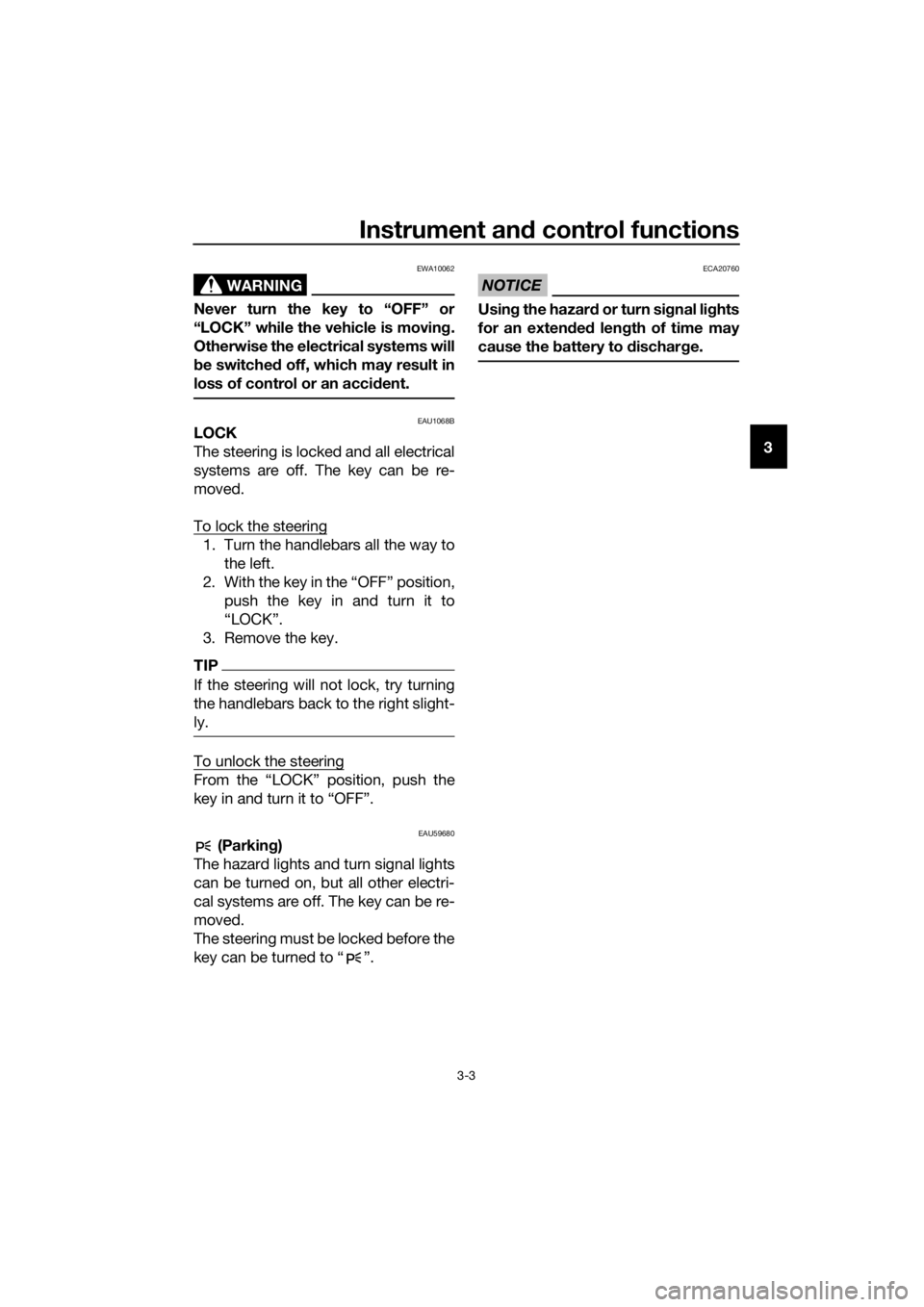
Instrument and control functions
3-3
3
WARNING
EWA10062
Never turn the key to “OFF” or
“LOCK” while the vehicle is moving.
Otherwise the electrical systems will
be switched off, which may result in
loss of control or an accident.
EAU1068BLOCK
The steering is locked and all electrical
systems are off. The key can be re-
moved.
To lock the steering
1. Turn the handlebars all the way to
the left.
2. With the key in the “OFF” position,
push the key in and turn it to
“LOCK”.
3. Remove the key.
TIP
If the steering will not lock, try turning
the handlebars back to the right slight-
ly.
To unlock the steering
EAU59680 (Parking)
The hazard lights and turn signal lights
can be turned on, but all other electri-
cal systems are off. The key can be re-
moved.
The steering must be locked before the
key can be turned to “ ”.
NOTICE
ECA20760
Using the hazard or turn signal lights
for an extended length of time may
cause the battery to discharge.
U2DME3E0.book Page 3 Friday, June 10, 2016 2:25 PM
Page 18 of 96
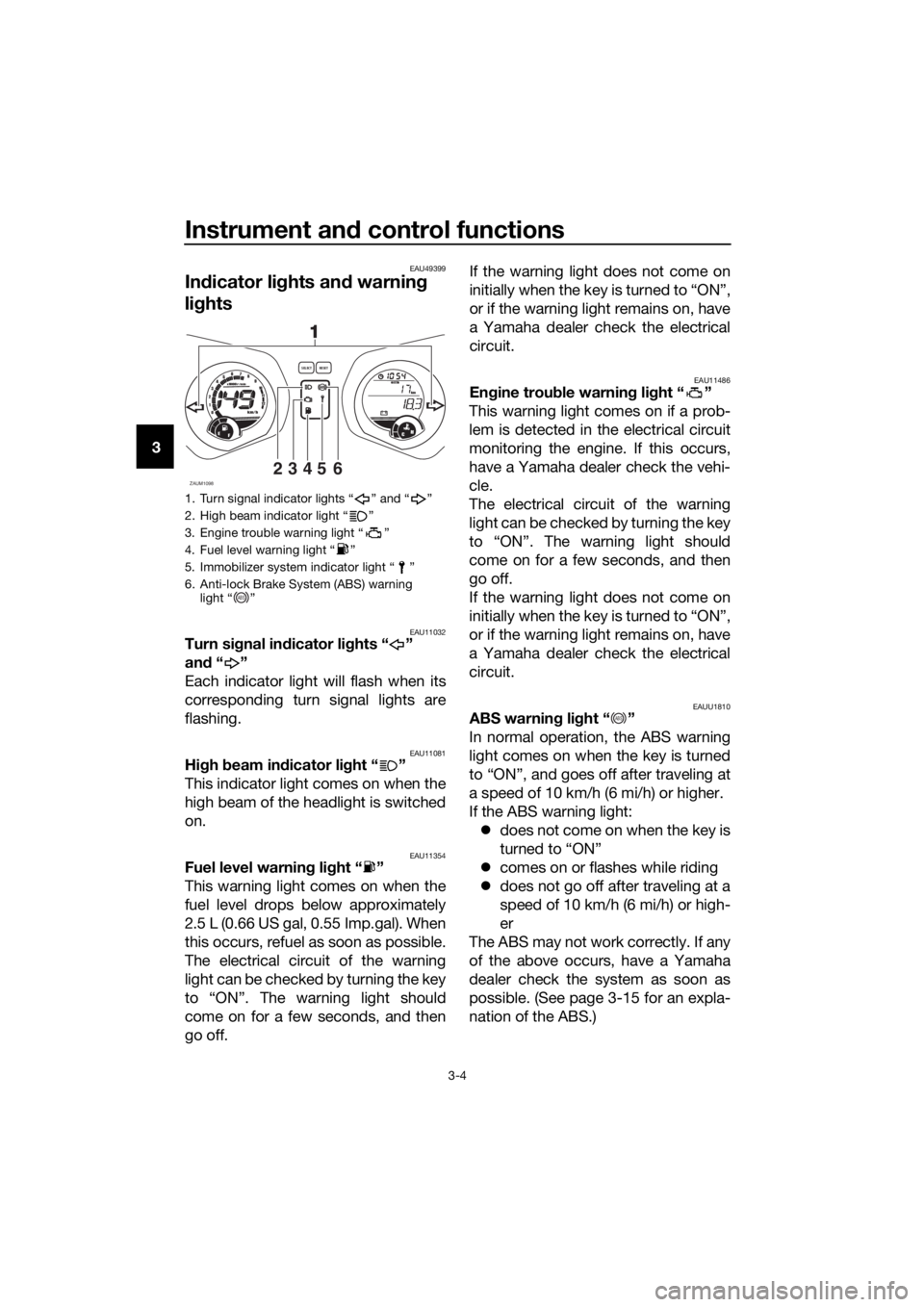
Instrument and control functions
3-4
3
EAU49399
Indicator lights and warning
lights
EAU11032Turn signal indicator lights “ ”
and“”
Each indicator light will flash when its
corresponding turn signal lights are
flashing.
EAU11081High beam indicator light “ ”
This indicator light comes on when the
high beam of the headlight is switched
on.
EAU11354Fuel level warning light “ ”
This warning light comes on when the
fuel level drops below approximately
2.5 L (0.66 US gal, 0.55 Imp.gal). When
this occurs, refuel as soon as possible.
The electrical circuit of the warning
light can be checked by turning the key
to “ON”. The warning light should
come on for a few seconds, and then
go off.If the warning light does not come on
initially when the key is turned to “ON”,
or if the warning light remains on, have
a Yamaha dealer check the electrical
circuit.
EAU11486Engine trouble warning light “ ”
This warning light comes on if a prob-
lem is detected in the electrical circuit
monitoring the engine. If this occurs,
have a Yamaha dealer check the vehi-
cle.
The electrical circuit of the warning
light can be checked by turning the key
to “ON”. The warning light should
come on for a few seconds, and then
go off.
If the warning light does not come on
initially when the key is turned to “ON”,
or if the warning light remains on, have
a Yamaha dealer check the electrical
circuit.
EAUU1810ABS warning light “ ”
In normal operation, the ABS warning
light comes on when the key is turned
to “ON”, and goes off after traveling at
a speed of 10 km/h (6 mi/h) or higher.
If the ABS warning light:
does not come on when the key is
turned to “ON”
comes on or flashes while riding
does not go off after traveling at a
speed of 10 km/h (6 mi/h) or high-
er
The ABS may not work correctly. If any
of the above occurs, have a Yamaha
dealer check the system as soon as
possible. (See page 3-15 for an expla-
nation of the ABS.)
1. Turn signal indicator lights “ ” and “ ”
2. High beam indicator light “ ”
3. Engine trouble warning light “ ”
4. Fuel level warning light “ ”
5. Immobilizer system indicator light “ ”
6. Anti-lock Brake System (ABS) warning
light “ ”
ZAUM109823456
98765432111 10
12
0
1000r/minx
km/h
E
FCH
kmOdoOdoSELECTRESET
11
ABS
ABS
U2DME3E0.book Page 4 Friday, June 10, 2016 2:25 PM
Page 19 of 96
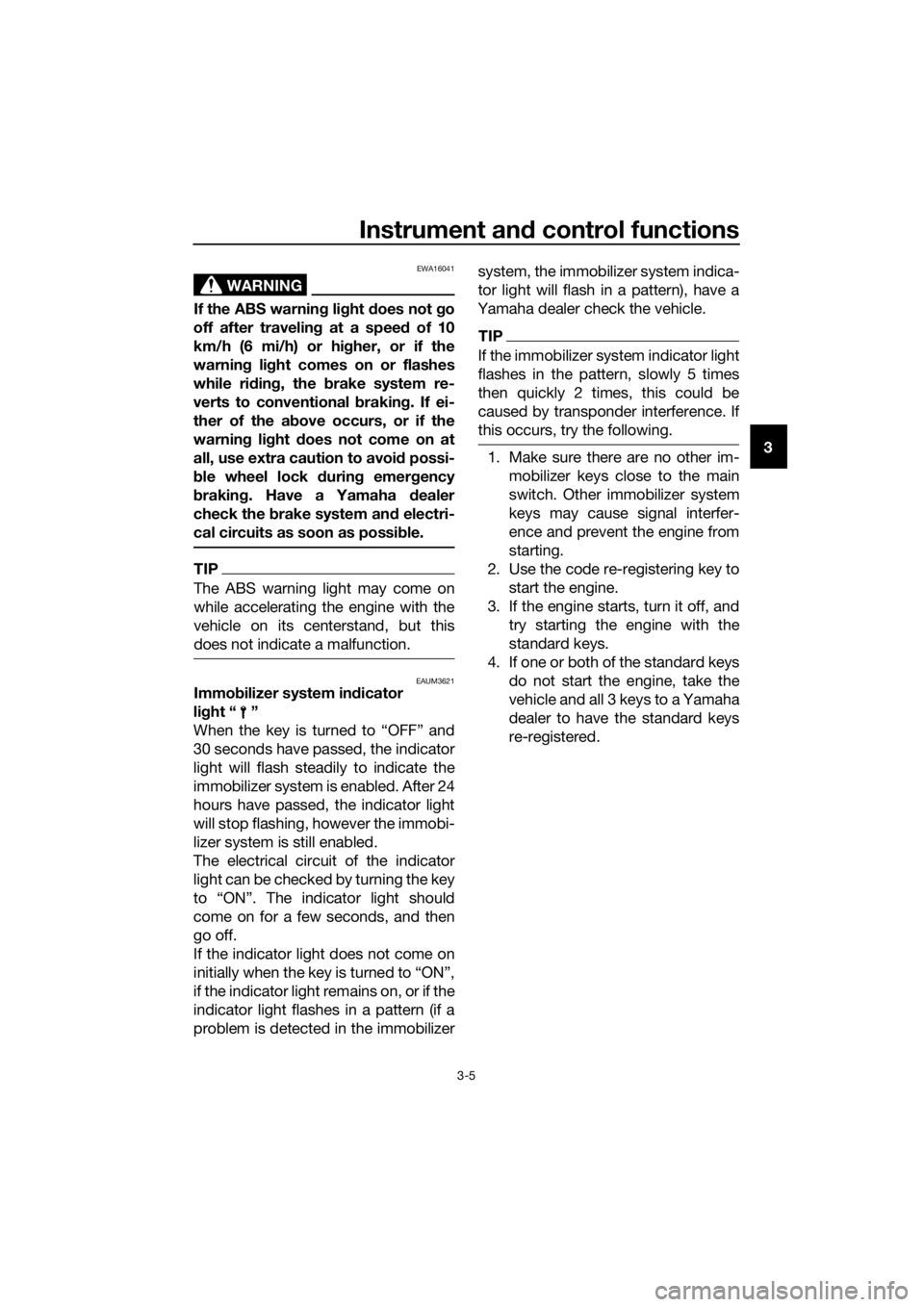
Instrument and control functions
3-5
3
WARNING
EWA16041
If the ABS warning light does not go
off after traveling at a speed of 10
km/h (6 mi/h) or higher, or if the
warning light comes on or flashes
while riding, the brake system re-
verts to conventional braking. If ei-
ther of the above occurs, or if the
warning light does not come on at
all, use extra caution to avoid possi-
ble wheel lock during emergency
braking. Have a Yamaha dealer
check the brake system and electri-
cal circuits as soon as possible.
TIP
The ABS warning light may come on
while accelerating the engine with the
vehicle on its centerstand, but this
does not indicate a malfunction.
EAUM3621Immobilizer system indicator
light “ ”
When the key is turned to “OFF” and
30 seconds have passed, the indicator
light will flash steadily to indicate the
immobilizer system is enabled. After 24
hours have passed, the indicator light
will stop flashing, however the immobi-
lizer system is still enabled.
The electrical circuit of the indicator
light can be checked by turning the key
to “ON”. The indicator light should
come on for a few seconds, and then
go off.
If the indicator light does not come on
initially when the key is turned to “ON”,
if the indicator light remains on, or if the
indicator light flashes in a pattern (if a
problem is detected in the immobilizersystem, the immobilizer system indica-
tor light will flash in a pattern), have a
Yamaha dealer check the vehicle.
TIP
If the immobilizer system indicator light
flashes in the pattern, slowly 5 times
then quickly 2 times, this could be
caused by transponder interference. If
this occurs, try the following.
1. Make sure there are no other im-
mobilizer keys close to the main
switch. Other immobilizer system
keys may cause signal interfer-
ence and prevent the engine from
starting.
2. Use the code re-registering key to
start the engine.
3. If the engine starts, turn it off, and
try starting the engine with the
standard keys.
4. If one or both of the standard keys
do not start the engine, take the
vehicle and all 3 keys to a Yamaha
dealer to have the standard keys
re-registered.
U2DME3E0.book Page 5 Friday, June 10, 2016 2:25 PM
Page 22 of 96
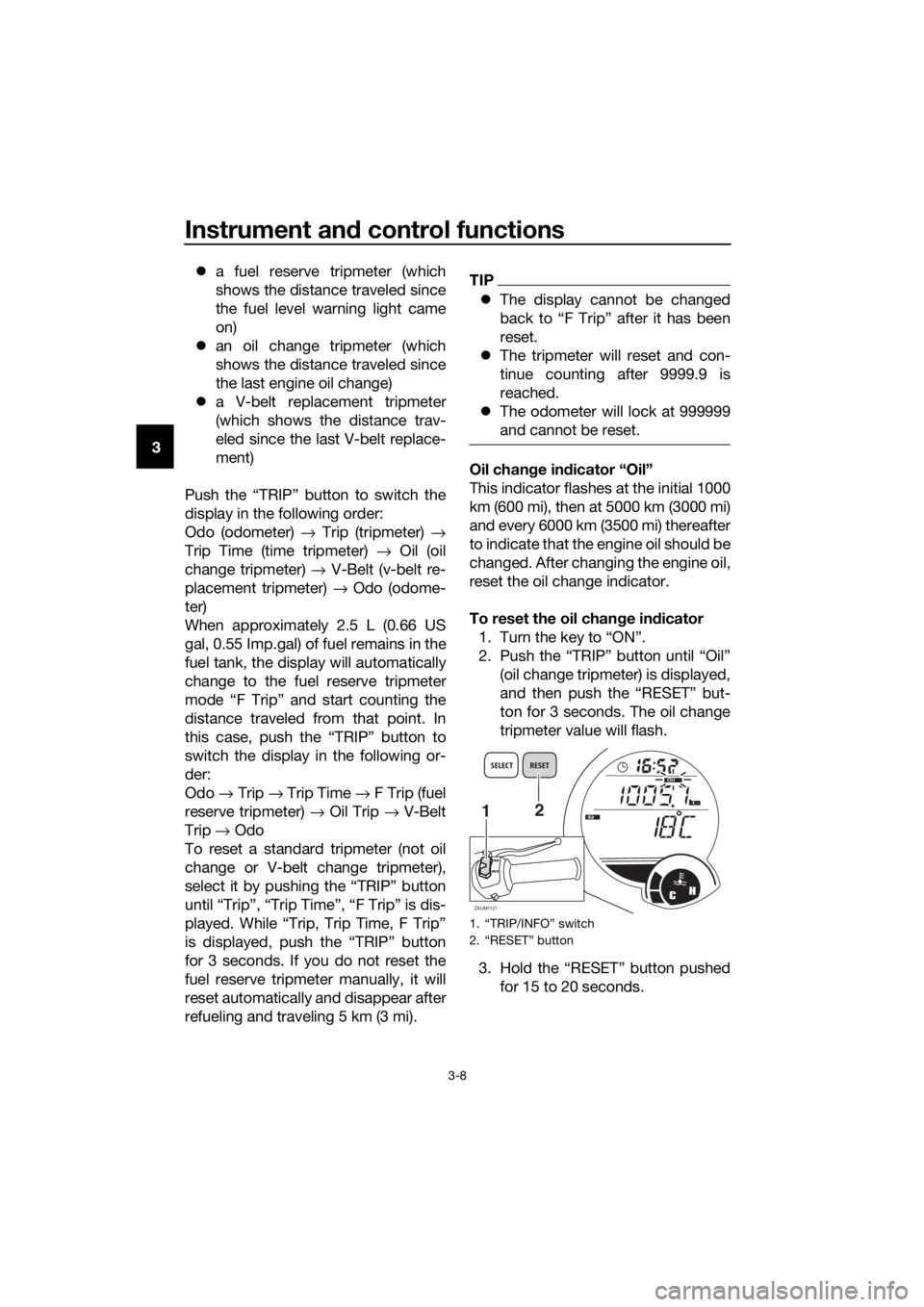
Instrument and control functions
3-8
3a fuel reserve tripmeter (which
shows the distance traveled since
the fuel level warning light came
on)
an oil change tripmeter (which
shows the distance traveled since
the last engine oil change)
a V-belt replacement tripmeter
(which shows the distance trav-
eled since the last V-belt replace-
ment)
Push the “TRIP” button to switch the
display in the following order:
Odo (odometer) → Trip (tripmeter) →
Trip Time (time tripmeter) → Oil (oil
change tripmeter) → V-Belt (v-belt re-
placement tripmeter) → Odo (odome-
ter)
When approximately 2.5 L (0.66 US
gal, 0.55 Imp.gal) of fuel remains in the
fuel tank, the display will automatically
change to the fuel reserve tripmeter
mode “F Trip” and start counting the
distance traveled from that point. In
this case, push the “TRIP” button to
switch the display in the following or-
der:
Odo → Trip → Trip Time → F Trip (fuel
reserve tripmeter) → Oil Trip → V-Belt
Trip → Odo
To reset a standard tripmeter (not oil
change or V-belt change tripmeter),
select it by pushing the “TRIP” button
until “Trip”, “Trip Time”, “F Trip” is dis-
played. While “Trip, Trip Time, F Trip”
is displayed, push the “TRIP” button
for 3 seconds. If you do not reset the
fuel reserve tripmeter manually, it will
reset automatically and disappear after
refueling and traveling 5 km (3 mi).
TIP
The display cannot be changed
back to “F Trip” after it has been
reset.
The tripmeter will reset and con-
tinue counting after 9999.9 is
reached.
The odometer will lock at 999999
and cannot be reset.
Oil change indicator “Oil”
This indicator flashes at the initial 1000
km (600 mi), then at 5000 km (3000 mi)
and every 6000 km (3500 mi) thereafter
to indicate that the engine oil should be
changed. After changing the engine oil,
reset the oil change indicator.
To reset the oil change indicator
1. Turn the key to “ON”.
2. Push the “TRIP” button until “Oil”
(oil change tripmeter) is displayed,
and then push the “RESET” but-
ton for 3 seconds. The oil change
tripmeter value will flash.
3. Hold the “RESET” button pushed
for 15 to 20 seconds.
1. “TRIP/INFO” switch
2. “RESET” button
ZAUM1121CH
kmAir
OilOdo
1
INFOTRIP
2
SELECT RESET
km
U2DME3E0.book Page 8 Friday, June 10, 2016 2:25 PM
Page 25 of 96
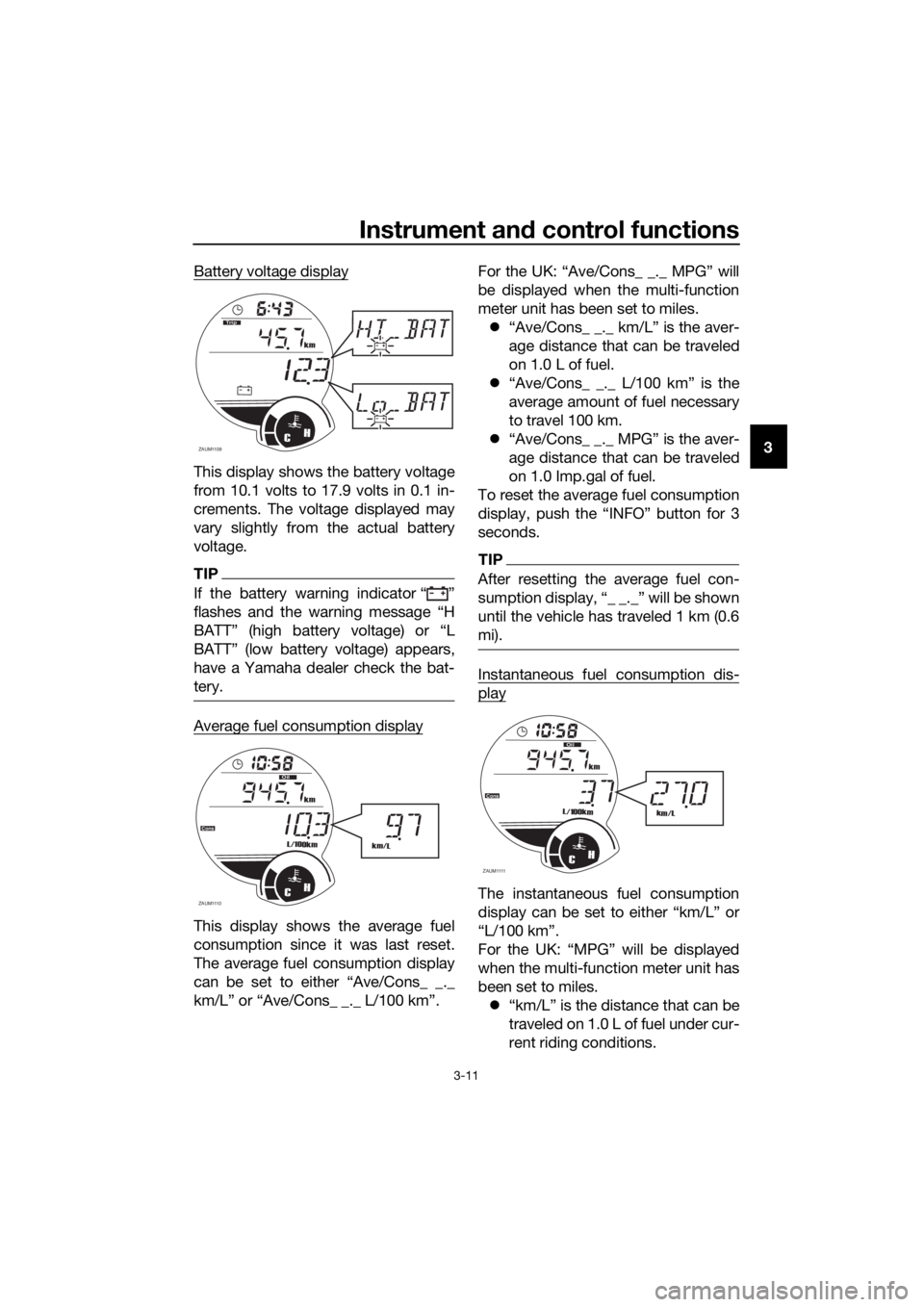
Instrument and control functions
3-11
3 Battery voltage display
This display shows the battery voltage
from 10.1 volts to 17.9 volts in 0.1 in-
crements. The voltage displayed may
vary slightly from the actual battery
voltage.
TIP
If the battery warning indicator Ž
BATTŽ (low battery voltage) appears,
have a Yamaha dealer check the bat-
tery.
Average fuel consumption display
This display shows the average fuel
consumption since it was last reset.
The average fuel consumption display
be displayed when the multi-function
meter unit has been set to miles.
“Ave/Cons_ _._ km/L” is the aver-
age distance that can be traveled
on 1.0 L of fuel.
“Ave/Cons_ _._ L/100 km” is the
average amount of fuel necessary
to travel 100 km.
“Ave/Cons_ _._ MPG” is the aver-
age distance that can be traveled
on 1.0 Imp.gal of fuel.
To reset the average fuel consumption
display, push the “INFO” button for 3
seconds.
TIP
After resetting the average fuel con-
until the vehicle has traveled 1 km (0.6
mi).
Instantaneous fuel consumption dis-
play
The instantaneous fuel consumption
when the multi-function meter unit has
been set to miles.
“km/L” is the distance that can be
traveled on 1.0 L of fuel under cur-
rent riding conditions.
ZAUM1109CH
km
T
rip
ZAUM1110CH
km
L/100km
Cons
Oil
km/L
ZAUM1111CH
km
L/100km
Cons
Oil
km/L
U2DME3E0.book Page 11 Friday, June 10, 2016 2:25 PM
Page 26 of 96
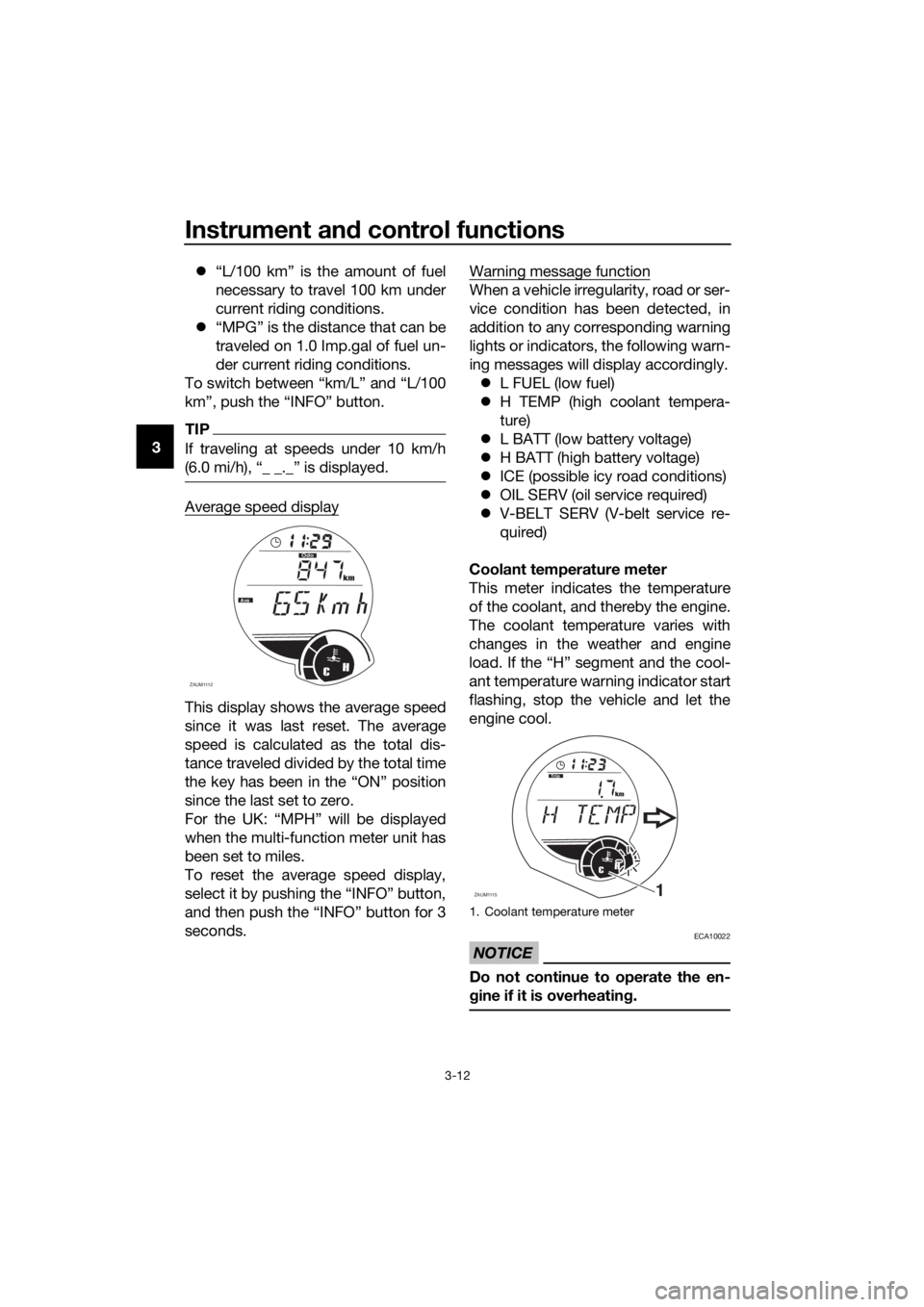
Instrument and control functions
3-12
3“L/100 km” is the amount of fuel
necessary to travel 100 km under
current riding conditions.
“MPG” is the distance that can be
traveled on 1.0 Imp.gal of fuel un-
der current riding conditions.
To switch between “km/L” and “L/100
km”, push the “INFO” button.
TIP
If traveling at speeds under 10 km/h
Average speed display
This display shows the average speed
since it was last reset. The average
speed is calculated as the total dis-
tance traveled divided by the total time
since the last set to zero.
when the multi-function meter unit has
been set to miles.
To reset the average speed display,
seconds.Warning message function
When a vehicle irregularity, road or ser-
vice condition has been detected, in
addition to any corresponding warning
lights or indicators, the following warn-
ing messages will display accordingly.
L FUEL (low fuel)
H TEMP (high coolant tempera-
ture)
L BATT (low battery voltage)
H BATT (high battery voltage)
ICE (possible icy road conditions)
OIL SERV (oil service required)
V-BELT SERV (V-belt service re-
quired)
Coolant temperature meter
This meter indicates the temperature
of the coolant, and thereby the engine.
The coolant temperature varies with
changes in the weather and engine
load. If the “H” segment and the cool-
ant temperature warning indicator start
flashing, stop the vehicle and let the
engine cool.
NOTICE
ECA10022
Do not continue to operate the en-
gine if it is overheating.
ZAUM1112CH
km
Odo
Ave
Cons
V- B e ltF
1. Coolant temperature meter
ZAUM11151
CH
km
Trip
U2DME3E0.book Page 12 Friday, June 10, 2016 2:25 PM
Page 27 of 96
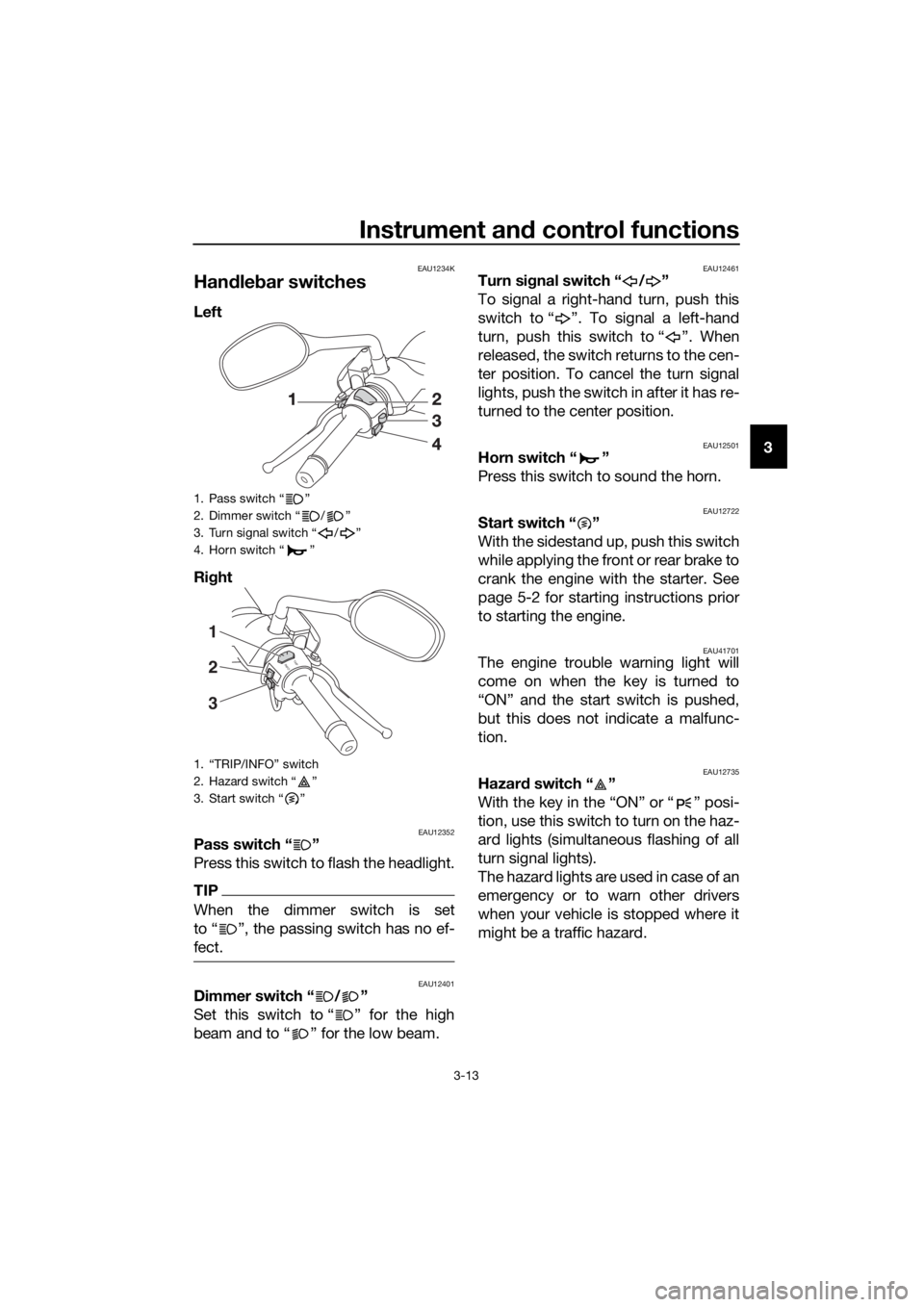
Instrument and control functions
3-13
3
EAU1234K
Handlebar switches
Left
Right
EAU12352Pass switch “ ”
Press this switch to flash the headlight.
TIP
When the dimmer switch is set
to Ž, the passing switch has no ef-
fect.
EAU12401Dimmer switch “ / ”
Set this switch to “ ” for the high
beam and to “ ” for the low beam.
EAU12461Turn signal switch “ / ”
To signal a right-hand turn, push this
switch to “ ”. To signal a left-hand
turn, push this switch to “ ”. When
released, the switch returns to the cen-
ter position. To cancel the turn signal
lights, push the switch in after it has re-
turned to the center position.
EAU12501Horn switch “ ”
Press this switch to sound the horn.
EAU12722Start switch “ ”
With the sidestand up, push this switch
while applying the front or rear brake to
crank the engine with the starter. See
page 5-2 for starting instructions prior
to starting the engine.
EAU41701The engine trouble warning light will
come on when the key is turned to
“ON” and the start switch is pushed,
but this does not indicate a malfunc-
tion.
EAU12735Hazard switch “ ”
With the key in the “ON” or “ ” posi-
tion, use this switch to turn on the haz-
ard lights (simultaneous flashing of all
turn signal lights).
The hazard lights are used in case of an
emergency or to warn other drivers
when your vehicle is stopped where it
might be a traffic hazard.
1. Pass switch “ ”
2. Dimmer switch “ / ”
3. Turn signal switch “ / ”
4. Horn switch “ ”
1. “TRIP/INFO” switch
2. Hazard switch “ ”
3. Start switch “ ”
I
N
FOTRI
P
1
3 2
U2DME3E0.book Page 13 Friday, June 10, 2016 2:25 PM
Page 29 of 96
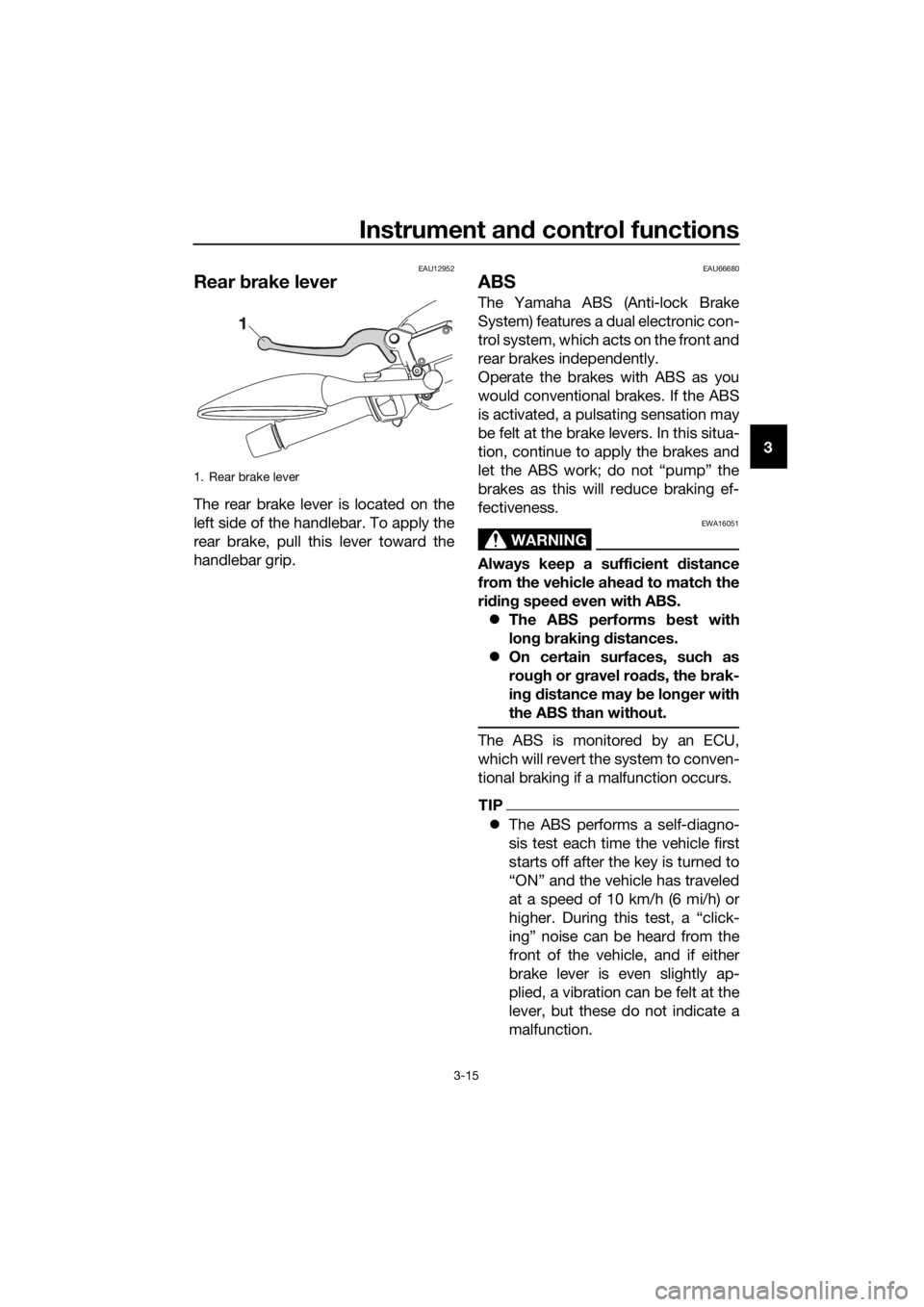
Instrument and control functions
3-15
3
EAU12952
Rear brake lever
The rear brake lever is located on the
left side of the handlebar. To apply the
rear brake, pull this lever toward the
handlebar grip.
EAU66680
ABS
The Yamaha ABS (Anti-lock Brake
System) features a dual electronic con-
trol system, which acts on the front and
rear brakes independently.
Operate the brakes with ABS as you
would conventional brakes. If the ABS
is activated, a pulsating sensation may
be felt at the brake levers. In this situa-
tion, continue to apply the brakes and
let the ABS work; do not “pump” the
brakes as this will reduce braking ef-
fectiveness.
WARNING
EWA16051
Always keep a sufficient distance
from the vehicle ahead to match the
riding speed even with ABS.
The ABS performs best with
long braking distances.
On certain surfaces, such as
rough or gravel roads, the brak-
ing distance may be longer with
the ABS than without.
The ABS is monitored by an ECU,
which will revert the system to conven-
tional braking if a malfunction occurs.
TIP
The ABS performs a self-diagno-
sis test each time the vehicle first
starts off after the key is turned to
“ON” and the vehicle has traveled
at a speed of 10 km/h (6 mi/h) or
higher. During this test, a “click-
ing” noise can be heard from the
front of the vehicle, and if either
brake lever is even slightly ap-
plied, a vibration can be felt at the
lever, but these do not indicate a
malfunction.
1. Rear brake lever
U2DME3E0.book Page 15 Friday, June 10, 2016 2:25 PM
Page 31 of 96
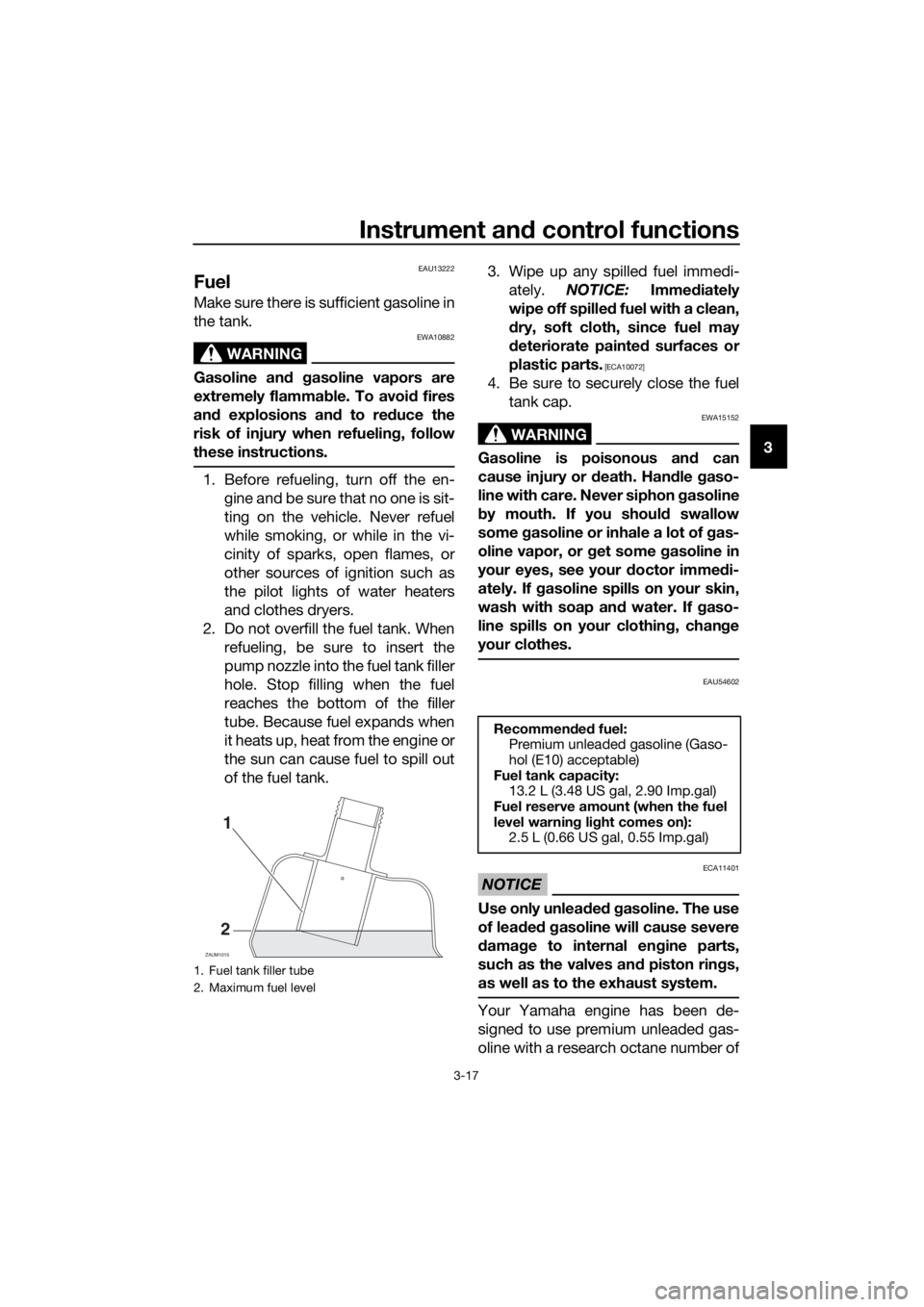
Instrument and control functions
3-17
3
EAU13222
Fuel
Make sure there is sufficient gasoline in
the tank.
WARNING
EWA10882
Gasoline and gasoline vapors are
extremely flammable. To avoid fires
and explosions and to reduce the
risk of injury when refueling, follow
these instructions.
1. Before refueling, turn off the en-
gine and be sure that no one is sit-
ting on the vehicle. Never refuel
while smoking, or while in the vi-
cinity of sparks, open flames, or
other sources of ignition such as
the pilot lights of water heaters
and clothes dryers.
2. Do not overfill the fuel tank. When
refueling, be sure to insert the
pump nozzle into the fuel tank filler
hole. Stop filling when the fuel
reaches the bottom of the filler
tube. Because fuel expands when
it heats up, heat from the engine or
the sun can cause fuel to spill out
of the fuel tank.3. Wipe up any spilled fuel immedi-
ately. NOTICE: Immediately
wipe off spilled fuel with a clean,
dry, soft cloth, since fuel may
deteriorate painted surfaces or
plastic parts.
[ECA10072]
4. Be sure to securely close the fuel
tank cap.
WARNING
EWA15152
Gasoline is poisonous and can
cause injury or death. Handle gaso-
line with care. Never siphon gasoline
by mouth. If you should swallow
some gasoline or inhale a lot of gas-
oline vapor, or get some gasoline in
your eyes, see your doctor immedi-
ately. If gasoline spills on your skin,
wash with soap and water. If gaso-
line spills on your clothing, change
your clothes.
EAU54602
NOTICE
ECA11401
Use only unleaded gasoline. The use
of leaded gasoline will cause severe
damage to internal engine parts,
such as the valves and piston rings,
as well as to the exhaust system.
Your Yamaha engine has been de-
signed to use premium unleaded gas-
oline with a research octane number of
1. Fuel tank filler tube
2. Maximum fuel level
ZAUM1015
1
2
Recommended fuel:
Premium unleaded gasoline (Gaso-
hol (E10) acceptable)
Fuel tank capacity:
13.2 L (3.48 US gal, 2.90 Imp.gal)
Fuel reserve amount (when the fuel
level warning light comes on):
2.5 L (0.66 US gal, 0.55 Imp.gal)
U2DME3E0.book Page 17 Friday, June 10, 2016 2:25 PM